Estimated reading time: 14 minutes
Thick creamy Greek yoghurt is super easy to make! Make it in a warm spot on the bench, in the Thermomix or in a Yoghurt Maker. This is literally a set-and-forget recipe if you have a TM6 or Yoghurt Maker. Even without fancy equipment, the recipe makes delicious homemade, natural, pot set yoghurt.
Please note there may be affiliate links in this post. For more information see my disclosure page or the bottom of this article.
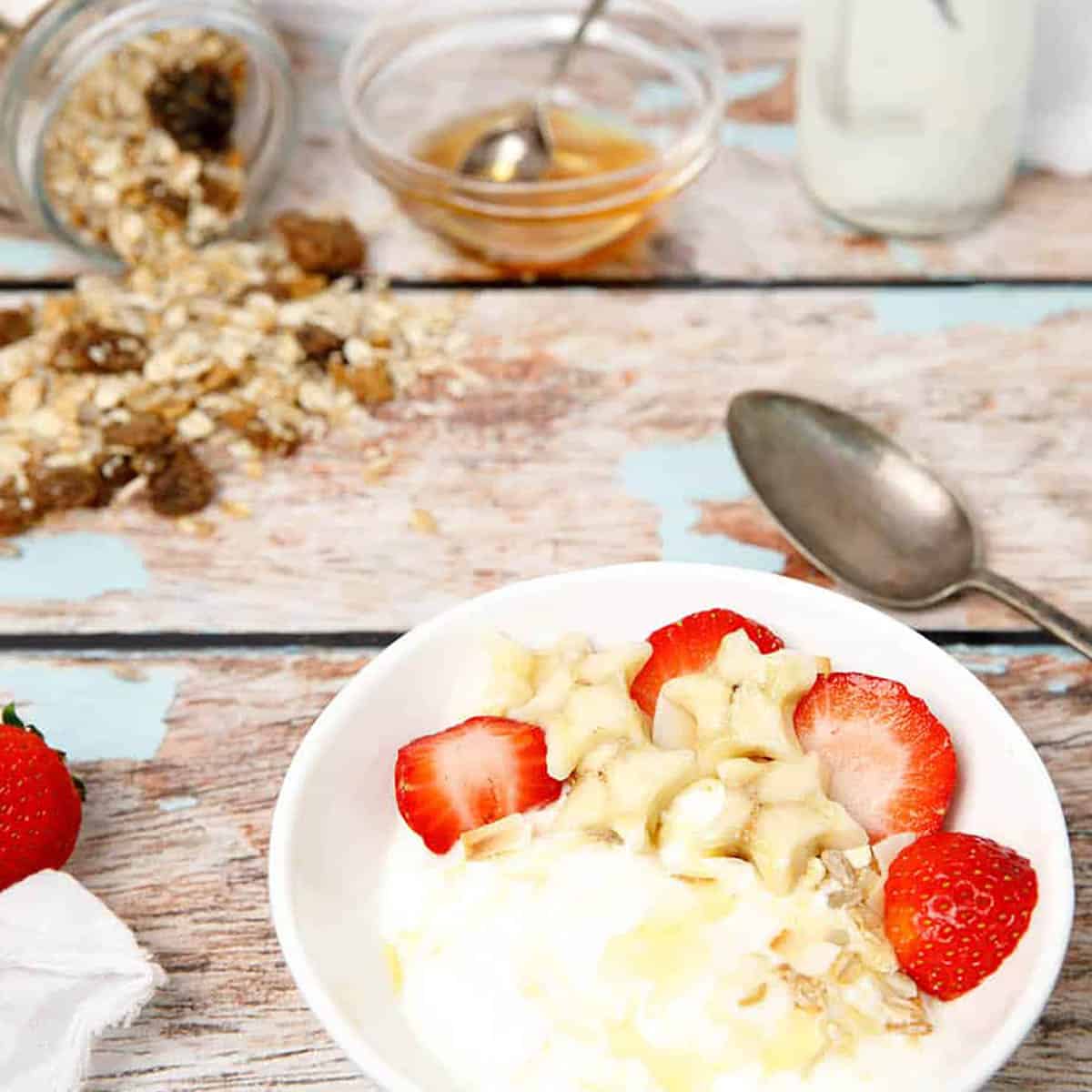
Table of contents
So many people have been asking me to share my recipe for creamy Greek-style yoghurt lately. I know it can be tricky to reproduce that thick, creamy premium yoghurt consistency, but with a good recipe and a few tips, you will nail the technique easily, every time.
The technique for yoghurt making will vary depending on whether you are culturing the yoghurt on your kitchen bench, have a Yoghurt maker or use a Thermomix, but the recipe remains the same.
Yoghurt Making Ingredients
First of all, I quite often get asked which starter yoghurt is best for yoghurt making and if skim milk is suitable. So I thought I would outline the ingredients I use in my recipe. There are only three ingredients used in my yoghurt recipe.
Milk
Use only full cream milk when making yoghurt. It will produce a thicker, creamier yoghurt and the cultures will multiply quicker when fed the optimum food, ie: full cream milk. I use full-cream UHT milk because;
- it's generally cheaper than refrigerated milk.
- the milk is kept at room temperature so it's quicker to heat.
- I always have reserves of UHT milk in the pantry so it's convenient
Yoghurt Starter
In the past, I've seen recommendations that only expensive brands of thick yoghurt be used as a culture. The truth is, any pot-set yoghurt will have the active cultures needed to create yoghurt. I would always use full cream, natural yoghurt as a starter.
I also share a recipe and story which shows how to make yoghurt using another technique. The method uses a yoghurt culture instead of yoghurt as a starter. Cultured Yoghurt Method
Milk Powder
Good quality milk full cream milk powder adds a delicious creaminess and gives the yoghurt cultures more goodness to feed upon whilst turning your milk into yoghurt. If you have ever reconstituted cheap milk powder you will know there is a taste difference between brands, so choose a brand you trust. The flavour of your yoghurt can vary depending on your choice.
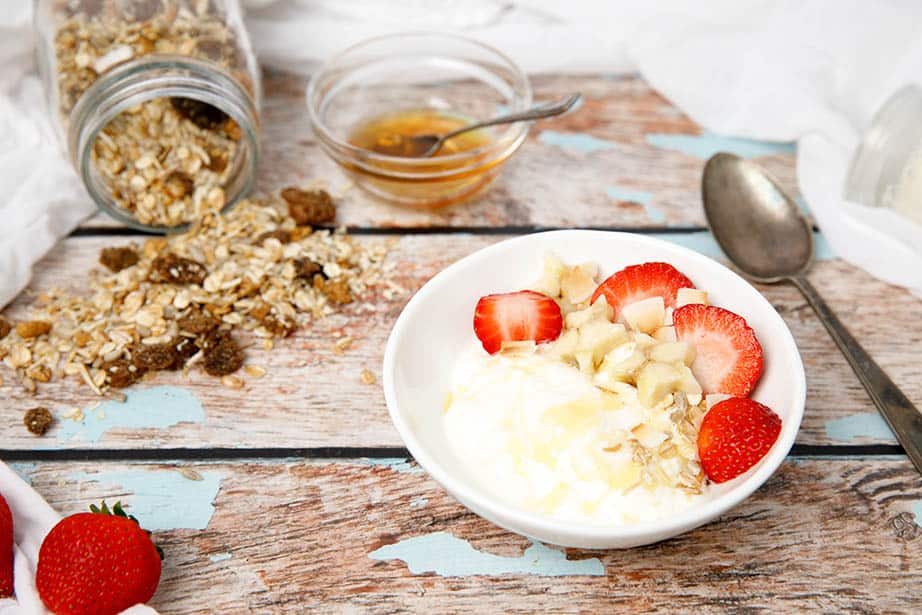
FAQ Greek Yoghurt Making Tips
The key to culturing yoghurt is keeping the yoghurt at the optimum temperature for a minimum of eight hours. The longer the yoghurt is allowed to culture the thicker and tangier the yoghurt will be. Culturing the yoghurt for longer also allows the bacteria to break down the lactose further making it more suitable for those with lactose digestion issues.
The easy answer, culture the yoghurt for a minimum of 8 hours and a maximum of 24 hours. Then refrigerate.
In my experience yoghurt cultures are best when maintained at between 38 - 50 degrees, or 102 - 120 Fahrenheit. It is most important that the temperature of the yoghurt is maintained adequately at the start of the process, (first five hours). Once the culture is active the yoghurt should still continue to the culture at body temperature although it will need longer to complete the process.
Temperatures over 53 degrees or 127 Fahrenheit will kill the active yoghurt culture and should be avoided.
Yoghurt that has been out of the fridge fermenting for 24 hours is still fine to eat. The bacteria would have consumed more of the sugar in the milk so the yoghurt may be more tart but it is still a healthy living food.
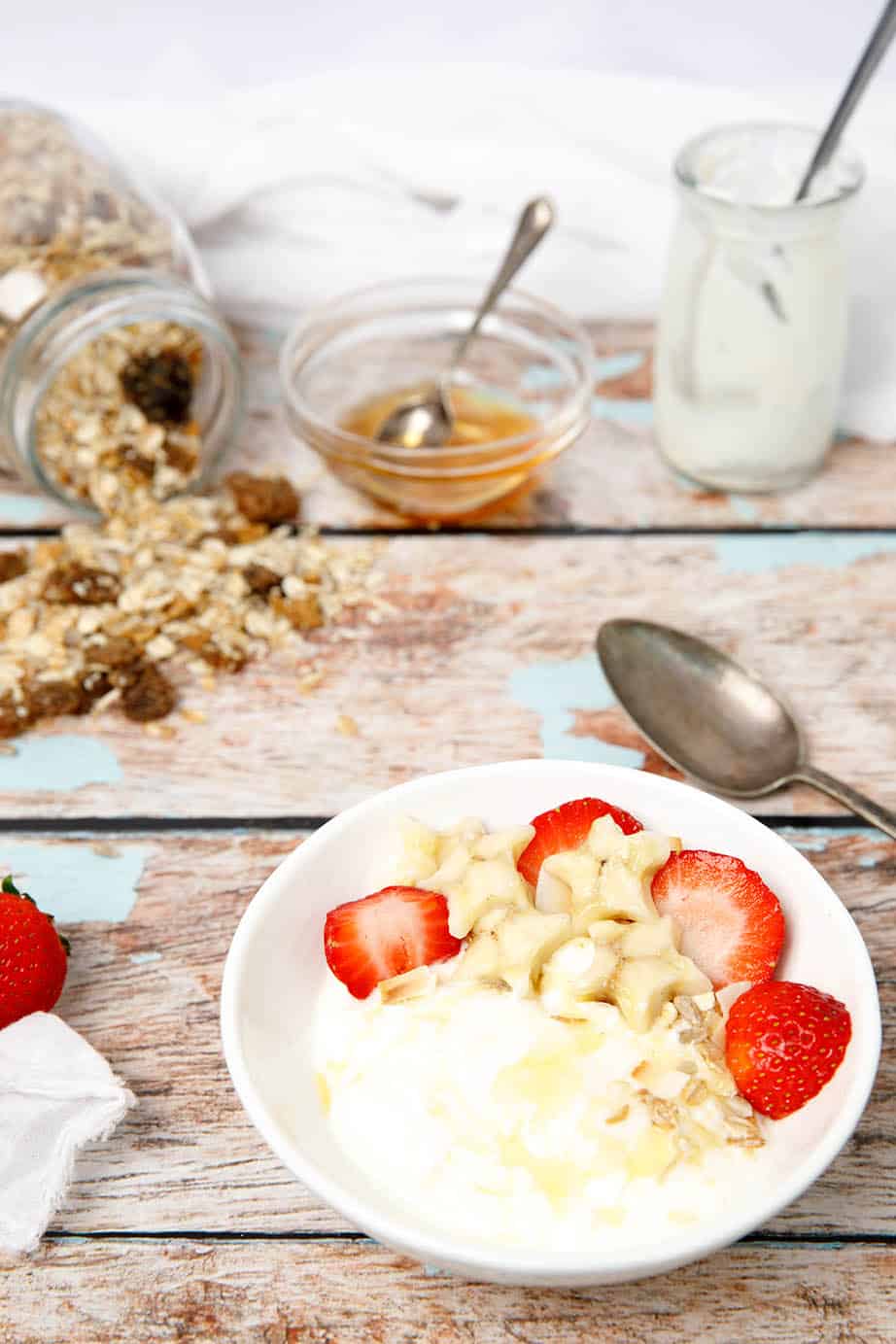
Yoghurt Making Methods
By now you have probably realised the key to successfully producing thick, creamy natural yoghurt comes down to culturing the yoghurt at the optimum temperature. There are a number of different methods used for maintaining the yoghurt temperature. The method you choose will depend on the equipment you have on hand.
If you consume a lot of yoghurts it may be useful to invest in a method which minimises the chance of failure and food wastage.
Benchtop Method
This method requires you to manually maintain the temperature of the yoghurt. Here are a few tips to help you:
- Place the yoghurt in a warm spot such as in front of a closed sunlit window.
- Add the yoghurt to glass jars and place in a sink full of warm water. Top up the warm water as necessary.
- Use my ThermoServer method below. *see video
Electric Yoghurt Maker
An electric yoghurt maker is a small, compact appliance which keeps the yoghurt at the optimum temperature. I have always used this model yoghurt maker because I also culture mascarpone cheese. Mascarpone has a longer culturing or processing time. If you are looking to purchase a yoghurt maker, ensure the machine has a timer which goes beyond 12 hours so you have the maximum functionality.
Using a yoghurt maker, simply make my recipe as per the instructions. Pour the yoghurt into the supplied container. Add the container to the appliance and then set the timer for 10 hours.
Remove the yoghurt and refrigerate until required.
Thermomix TM6
If you have a TM6 you're in luck!! Your yoghurt maker is a built-in function! No need to carefully watch and maintain the temperature of the yoghurt in a ThermoServer AND no need to purchase a Yoghurt maker!
Simply watch the video below and follow the steps in the recipe.
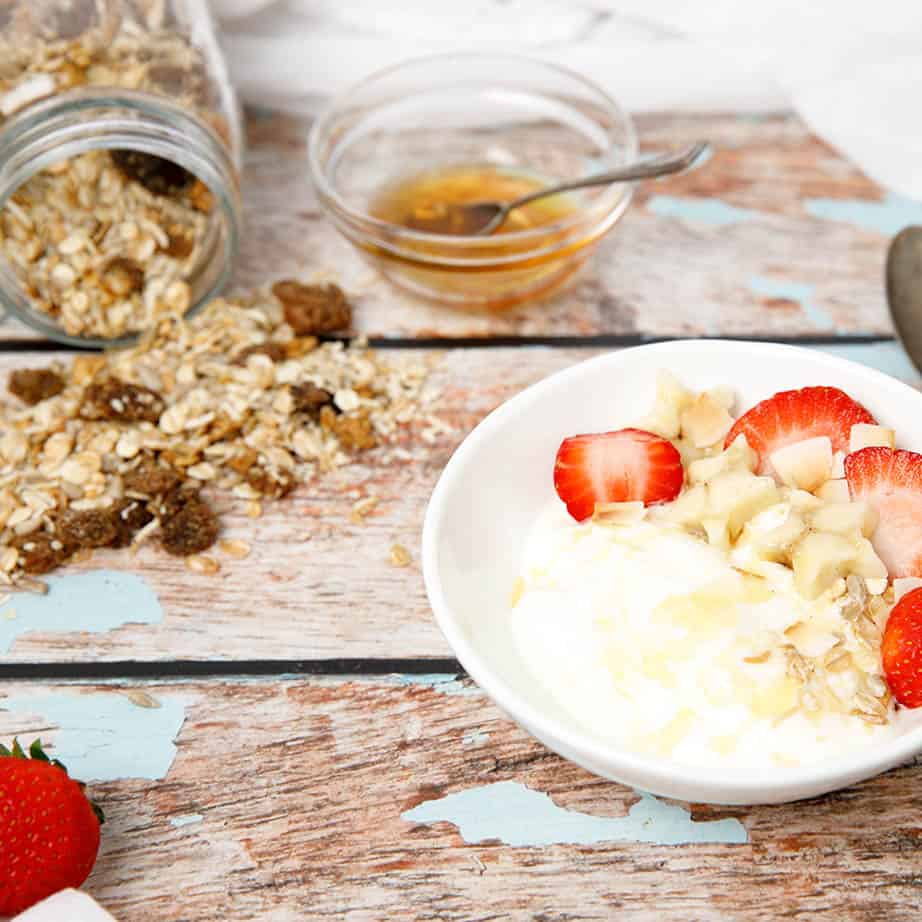
Easi-Yo Flavoured Yoghurt
If you're looking at a cheat way of making flavoured yoghurt fast, take a look at my story about Easi-yo Flavoured yoghurt. This is a great option if you have kids who enjoy copious quantities of expensive flavoured yoghurt. This homemade flavoured yoghurt costs approximately $2.50 for 1 litre. This yoghurt can be cultured using any one of the above methods.
My Website Runs on Coffee & Love
If you enjoy my recipes, please consider shouting me a coffee and help me keep the free content coming.
Julie xx

How to Serve Greek Yoghurt
Greek yoghurt can be used as a savoury or sweet base. Here are some ideas for making the most of your homemade Thermomix Yoghurt.
- Serve with Lemon Curd for a Lemon Yoghurt
- Swirl through some Passionfruit Curd
- Top with some homemade Healthy Granola
- Use it as the base of a salad dressing with chopped herbs.
- Save money by adding it to your Easy Chicken Curry
Let’s Connect!
I share loads of great recipes on the page. Our community group page is a fabulous place to ask questions and share images of recipes you have made! It helps inspire others to cook new and interesting dishes.
If you want more Thermomix recipe ideas, please follow the ThermoKitchen FB Page.
For more Thermomix recipe inspiration LETS CONNECT on;
FACEBOOK
TWITTER INSTAGRAM PINTEREST YOUTUBE
Recipe Serving Adjustments
Please note, that although the recipe card allows you to change the serving size and adjust the recipe this SHOULD NOT be done. Adjusting a Thermomix recipe will lead to unexpected and undesired outcomes. Please always stick to the exact ingredient quantities and times given in my recipe.
*The recipe card is generic and designed for all websites, this is a feature I can't remove.

Thermomix Greek Yoghurt Natural
Ingredients
- 1000 g Full Cream UHT Milk at room temp (you can use regular milk but it will need to be heated, see instructions)
- 80 g Full Cream Milk Powder
- 80 g pot set natural yoghurt used as a starter culture
Steaming
- 350 g Hot tap water
- 1 TBS white vinegar used to clean the bowl as it steams
Instructions
UHT Milk Method
- Add the UHT milk, milk powder and yoghurt starter to the TM Bowl1000 g Full Cream UHT Milk, 80 g Full Cream Milk Powder, 80 g pot set natural yoghurt
- Combine 10 sec/Speed 7. Scrape down bowl.
- Repeat, Mix 10 sec/Speed 9.
- Heat 2 min/37 degrees/Speed 2
- Pour the yoghurt into the yoghurt pots. or a 1 litre ThermoServer
Regular Milk Method
- Place the milk in the TM Bowl. Heat 10 min/100 degrees/Speed 2.
- Allow the milk to cool to 40 degrees. Approx 45 min.
- Add the milk powder to the cooled milk. Combine 10 sec/Speed 7.
- Add the yoghurt to the milk. Combine 10 sec/Speed 7.
- Heat the culture. 2 min/40 degrees/Speed2
- Pour the yoghurt mixture into 8 mini glass pots, add the lids to the pots.
Fermenting Yoghurt TM6
- Place the yoghurt pots or the white ThermoServer. Place into the deep Varoma dish and add the lid.
- Wash the TM Bowl and add the hot tap water and vinegar to the TM bowl.
- Place the Varoma dish on the TM Bowl. Ferment Mode /70 degrees/10 hours.
- Once complete, refrigerate the yoghurt until required.
Bench Top Yoghurt Culturing - Fermenting TM5 & TM31
- Wash and submerge the Thermoserver and lid in boiling water to heat the dish.
- Heat 550g water in the TM Bowl. 6 min/90/Speed 1350 g Hot tap water, 1 TBS white vinegar
- Pour water into the pre-heated Thermoserver.
- Add the prepared yoghurt pots to the ThermoServer. Leave covered for 5 hours.
- Heat 150g water in TM bowl. 3 min/70 degree/Speed 1
- Replenish the ThermoServer with additional 150g of heated water. (Leave the original water in the ThermoServer.) Allow the yoghurt to ferment for another 5 hours.
- Once complete, refrigerate the yoghurt until required.
Video
Notes
Nutrition
I hope you have enjoyed this story. Feel free to leave a comment or start a discussion. If you have made a dish from this site I would love to know what you thought!
Leaving a comment and a star rating helps others decide if they should try my recipe. Plus if you hit the social media share buttons, your friends may find a delicious new recipe or Thermomix Tip too!
If you want to be notified when a new recipe is released sign up for my monthly newsletter. The form is also in the footer!
Thank you for stopping by,
Happy Cooking
j xx

Link Disclosure
From time to time I recommend kitchen products and ingredients. These are always items I use and love! When I share a link to a product you can rest assured that I have tested the item and genuinely love it! If you follow my link and purchase the item in some cases I will receive a commission for the referral.
Whilst the commission may only be $1 or so, I value your support, and I take your trust very seriously.
By clicking on my link, or selecting my name "Julie Carlyle" as the referer you reward me with a small commission that helps support me and this website.
Your support keeps me cooking!


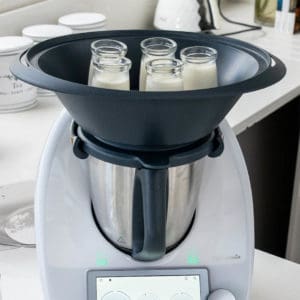

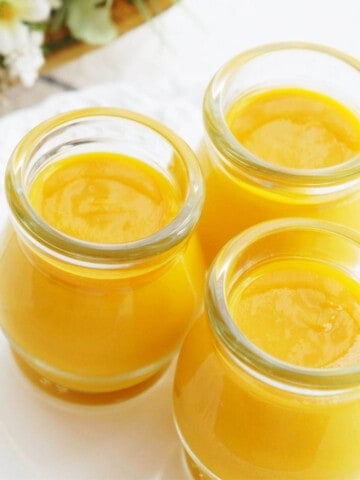
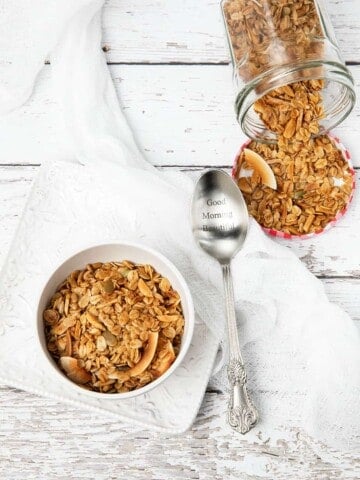
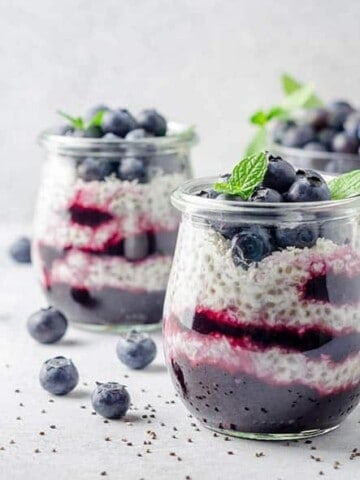
Sharon Fisher says
This is a super easy way to make yoghurt! After many years of heating milk and waiting for it to cool, using UHT milk makes it SO much easier! Thanks Julie!
Julie Carlyle says
Hi Sharon
I am so pleased this tip has helped you! It was a game changer for me! I don't have the patience to wait for 100 degree milk to cool! UHT milk has already had the procees completed and has remained sealed! WIN
Thank you so much for commenting.
Julie
Esther says
My go-to recipe for greek yogurt. I use A2 milk for the extra protein and works perfectly every time! Tonight I am doubling the recipe to see if it works. I presume taking it to the same temperatures is key (obviously takes longer than 6 minutes to heat 2 L of milk to 70 degrees)
Fingers crossed!
Karlie says
My yoghurt is runny and a bit curdly. It looks like it's not set. I'm trying to work out if I can save it! I didn't have small pots so I used 2x 500g preserving jars with lids in the varoma using ferment mode (tm6). Is there a chance it didn't get hot enough? I did it for 10 hours because I wanted Greek yogurt. Have you ever tried doing this in the tm bowl instead of using the varoma? I wonder if it would do better at keeping the temperature consistent...?
Julie Carlyle says
Hi Karlie
I have never had a runny result. The Varoma does keep the yoghurt at a good enough temperature. It sounds like the starter yoghurt you were usingdidn't have a strong enough strain of yoghurt bacteria. Was the starter yoghurt pot set and recently opened? If it is getting near the due date the yoghurt bacteria can be dying off. Was it plain natural yoghurt? The yoghurt can't be made in the Thermomix Bowl, the heat element would kill the bacteria :(.
Kind Regards
Julie
Joanne Deroos says
If you don’t have kids for glass cups can you cover instead with anything
Julie Carlyle says
Hi Joanne
Thank you for your question. Yes, if you don't have lids just cover the glass or jar with plastic wrap. Just make sure the moisture can't get in.
Happy Cooking
j xx
Jenny says
Hello Julia. Did you realise the UHT milk recipe doesn’t say to heat the milk?
Julie Carlyle says
Hi Jenny
The Uht milk only gets heated to between 37-40 degrees once all the ingredients are added. This is because it comes out of a sealed container and the milk inside has already been heated treated to remove bad bacteria.
Happy Cooking
Julie
Bruna Jackson-Hope says
Hi there. Do I need to put the kids on the pots as I put them on the varoma? I notice on your video you say to do it but you don’t seem to put it on? I’m confused 🙂
Thank you
Julie Carlyle says
Hi Bruna
Thank you for your question. Yes absolutely put the lids on the pots or the water will get into the yoghurt. I am so sorry about the confusion, I get nervous and forgetful when I am filming and talking to the camera.
Happy Cooking Julie
Ho Kye says
I assume this is 70 Celsius? Thank you!
Julie Carlyle says
Hi Ho
Yes it is in Degree's Celcius, sorry for the confusion.
J xx
Julie Carlyle says
Hi Ho
Yes that is correct. It is indirect heat from the steam.
Julie
Pam says
If I wanted it sweetened, when and what would you add..
Julie Carlyle says
Hi Pam
Thank you for your question.
Any flavours or sweetening is done when you are ready to eat the yoghurt.
Happy Cooking
Julie
Lorna says
Hi, I presume this would work with lactose free Greek yoghurt (instead of natural yoghurt) as the starter, and also lactose free long life milk? Thanks 🙂
Julie Carlyle says
Hi Lorna
I wish I could be more help... but I really don't know. If you try it with a lactose free starter and milk could you please come back and let me know. 🙂
Thank you
Julie
Sylvia Jenkins says
Ill never be buying yoghurt again after trying this reicpe. Worked a treat
Crizette Yap says
Hello Julie,
Thank you for sharing your recipes. I just want to ask i bought cultures for health greek yogurt starter culture. How many grams should i use? Thanks
Julie Carlyle says
Hi Crizette
You will only need 1/8th of a teaspoon. Just a tiny amount.
Happy Cooking
j
Bree says
Hi Julie,
This recipe is great! delicious greek yoghurt that is better than supermarket bought! The only thing i am noticing is it's just a little runny and i'd like it thicker. What do i change to get a thicker yoghurt? Thanks so much!
Julie Carlyle says
Hi Bree
I’m so pleased you’re enjoying the recipe.
If you leave the yoghurt longer the fermentation will continue and the yoghurt will become thicker. Also, always use full cream milk and the milk powder for the thickest yoghurt.
Happy Cooking
Julie
Kaisa Rayner says
I made this last night and cant believe how good it turned out. Very happy with the results
Sharon McLennan says
Hi Julie thanks for a easy to follow explanation on how to make Greek Yoghurt. My son has 2 British Bulldogs & their diet includes Greek Yoghurt daily which costs a small fortune, so I'd like to try this easy recipe. What can I ferment the batch in instead of small pots?
Julie Carlyle says
Hi Sharon
Thank you for your lovely comment. I'm so pleased your bulldogs like my yoghurt 🙂 You can ferment the yoghurt in 250gm jam jars if you like. Just make sure you ferment with the lid on 🙂
Happy Cooking
j
Debbie Fireman says
Do you need to heat the milk and cool if you use UHT milk? Do you just need to keep it at 37-40 degrees?
Julie Carlyle says
Hi Debbie
Heat treated milk, if it is in an unopened package doesn’t need to be reheated beyond warming the milk for the culture.
Happy cooking
J
Eileen Dunlop says
Hi Julie. I have a TM31. Could I try using the same process as Julie Carlyle and ferment my yoghurt in pots in the varoma, rather than the thermoserver please?
I don't have the ability to upgrade my machine at the moment.
Thank you xx
Julie Carlyle says
Hi Eileen
Yes you could make yoghurt this way. Use the same process. Every hour just heat the water in the Tm jug to 70 degrees so the Varoma stays warm for 12 hours.
Happy cooking
J
Claudia says
Hi,
I would like to use actual culture rather than yogourt as a starter. Is the recipe out yet?
Thanks
Julie Carlyle says
Hi Claudia yes the recipe is available. You should find the link in the story.
Julie
Liz Muir says
I have a TM 5, & want to try the Varoma on top of the jug method. Is it 8 hours, 70° at speed 1, with a litre of water?
Julie Carlyle says
Hi Liz
The TM6 cycles on and off over the 8 hour period so the culture in the Varoma is kept at a fairly constant 40 degrees. I'm not sure you could do that with the TM5. Plus you would have the machine working the whole 8 hours. If you wanted to try I would only set the TM5 on to 50 degrees for 8 hours.
Let me know how you go.
Julie
Rachel Pengelly says
I wanted to make the Greek yoghurt low fat would that work and if so would I just use low fat milk and milk powder?
Julie Carlyle says
Hi Rachel
I am sorry to say that using low-fat products doesn't produce low-fat yoghurt. The active bacteria need full-fat milk. In the commercial products, the fat is later removed after the culture process. It's not really possible to make low-fat yoghurt at home.
Julie
Alicia says
I love this yoghurt. It really is delicious and creamy. I use it for frozen yoghurt and labne as well as yoghurt on my breakfast cereal.
Alicia says
This was so easy. I haven’t bought yoghurt pots for my TM6 yet so sat my thermi server on top of the bowl lid without the mc. Thank you
Julie Carlyle says
Alicia
Awesome! I’m so pleased you enjoyed the recipe.
Julie
Lauren Kreuger says
Hi. I love the little glass pots. Is there a version of that available at any of the major aussie retailers? I'm looking to get it cheaper than the TM product. Thanks.
Julie Carlyle says
Hi Laura
Yes there is! If you go to the defect shop they often have 200ml glass jars with clear plastic lids. I have some with hearts on them. I think their $2.00 each. 5 will fit in the Varoma and make one litre of yoghurt.
Happy Cooking
J
Simone says
Just wondering if you can make this yoghurt in one big pot? Will anything change to the cooking time?
Julie Carlyle says
Hi Simone
The cooking time doesn’t change if you change the size of the pot.
Happy Cooking
J
Pamela says
Hi Julie,
I'd like to make the yoghurt with goat's milk for my lactose intolerant family. Have you used goat's milk to make yoghurt? Any suggestions for those of us who love yoghurt and are lactose intolerant?
Julie Carlyle says
I’m sorry, I really don’t know if goats milk works as I have never tried. If you do try please let me know.
J